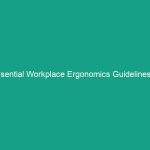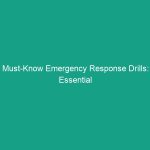Good Morning Team!
Today, we’re going to talk about something that affects each one of us on the job: essential guidelines to identify and mitigate unsafe conditions. Safety is not just a checklist; it’s a culture that we create together. Understanding how to spot Hazards and take action can make a significant difference in our daily operations and overall well-being.
Understanding Essential Guidelines to Identify and Mitigate Unsafe Conditions
So, what do we mean by “essential guidelines to identify and mitigate unsafe conditions”? Essentially, it refers to the proactive measures we take to recognize potential Hazards in our workplace and implement strategies to eliminate or reduce those risks. This is crucial because unsafe conditions can lead to injuries, accidents, and even loss of life.
It’s a common misconception that Safety is solely the responsibility of management. In reality, every employee plays a vital role in maintaining a safe Environment. By developing an acute awareness of our surroundings and understanding Safety protocols, we can significantly reduce workplace hazards.
Key Hazards, Risks, and Safety Considerations
Identifying unsafe conditions requires a keen eye and familiarity with common workplace hazards. Here are some of the most prevalent risks:
- Slips, Trips, and Falls: Often caused by wet floors, uneven surfaces, or obstructions.
- Electrical Hazards: Exposed wires, overloaded circuits, and improper grounding.
- Ergonomic Risks: Poor workstation setup leading to strain and injury.
- Chemical Exposures: Inadequate labeling, storage, or handling of hazardous materials.
Ignoring these hazards can lead to serious consequences, including injuries that may result in lost time, medical expenses, and even legal ramifications for the company. Remember, safety isn’t just about compliance; it’s about caring for ourselves and each other.
Best Practices, Procedures, & Actionable Advice
Let’s dive into some practical steps we can take to identify and mitigate unsafe conditions:
1. Conduct Regular Safety Inspections
Make it a habit to inspect your work area regularly. Look for potential hazards and report them immediately. Use a checklist to ensure you don’t miss any critical areas.
2. Report Unsafe Conditions
If you see something, say something! Reporting unsafe conditions is everyone’s responsibility. Our management team is here to ensure your safety, and they need your eyes and ears to help.
3. Follow Safety Protocols
Adhere to established safety Procedures. Whether it’s wearing Personal Protective Equipment (PPE) or following lockout/tagout procedures, compliance is key to preventing accidents.
4. Engage in Safety Training
Continuous learning is crucial. Participate in safety training sessions and workshops. These will equip you with the knowledge needed to recognize and mitigate hazards effectively.
5. Share Real-Life Examples
Let’s learn from incidents that have occurred in the past. For instance, consider the case of a worker who suffered a back injury due to improper lifting techniques. By sharing stories, we can understand the importance of following safety protocols.
Regulations, Standards, and Compliance
It’s essential to understand the Regulations and Standards that guide our safety practices. The Occupational Safety and Health Administration (OSHA) sets forth numerous standards to protect employees. Compliance with these regulations is not just about avoiding fines; it’s about ensuring each other’s safety.
For example, osha requires that all workplaces maintain a safe environment free from recognized hazards. Familiarizing yourself with these standards can empower you to advocate for a safer workplace.
Employee Engagement & Discussion
Now, let’s open the floor for discussion. Here are some questions to consider:
- What specific safety challenges have you encountered related to identifying unsafe conditions?
- Can anyone share a time when reporting a hazard made a difference?
- How can we improve our current safety protocols?
Feel free to share your thoughts and experiences. Remember, safety is a collective effort, and your input is invaluable.
Conclusion & Key Takeaways
In conclusion, we’ve covered essential guidelines to identify and mitigate unsafe conditions in our workplace. Remember:
- Stay vigilant and conduct regular inspections.
- Don’t hesitate to report unsafe conditions.
- Adhere to safety protocols and participate in training.
- Engage in open discussions about safety challenges.
By prioritizing safety, we protect ourselves and our coworkers. Thank you for your attention and commitment to creating a safe working environment. Remember, safety starts with you!


